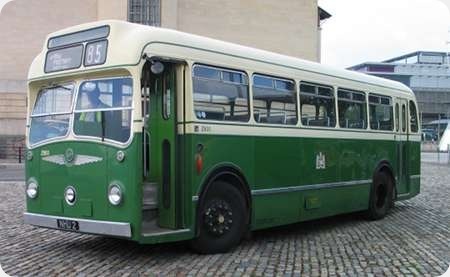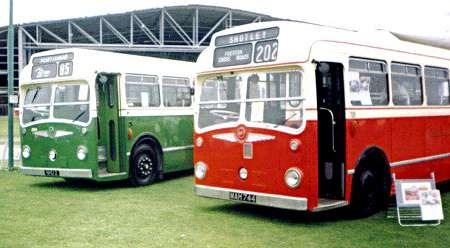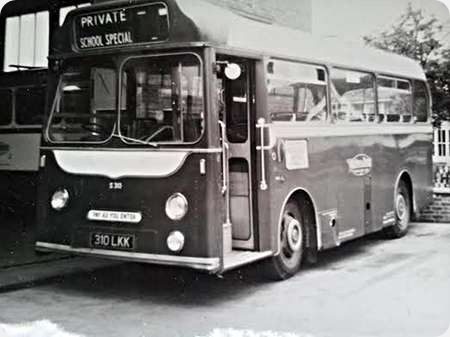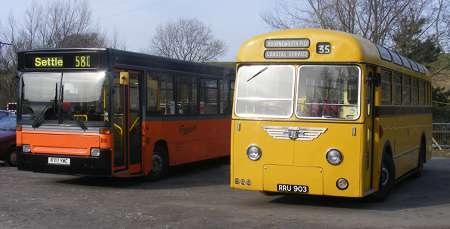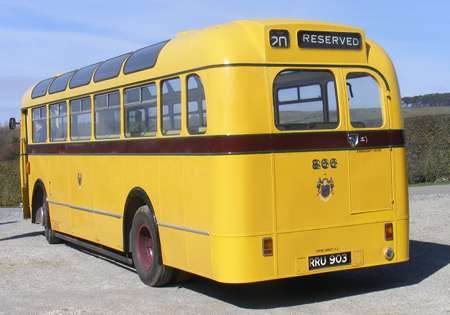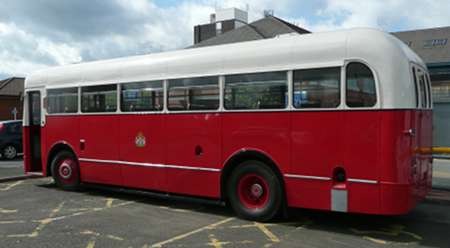Bristol Tramways – Bristol LS – NHU 2 – 2800
Bristol Tramways & Carriage Company Limited
1950
Bristol LSX5G
ECW B42D
This Bristol LSX5G with chassis number LSX.001 was new to Bristol Tramways in 1950 and has an Eastern Coachworks B42D body numbered 4978. It was, as its chassis number suggests, a prototype. Seen here at the Bristol Waterfront Running Day 22/05/2011.
Photograph and Copy contributed by Les Dickinson
07/06/15 – 10:12
Nice, Les! Another for me to delete from my list of possible future submissions . . .
Pete Davies
08/06/15 – 07:25
This image is scanned from my original print so not great, however it is a piece of history. The two prototypes were together for the first time in 54 years here at Showbus 2005. The red one is Eastern Counties LL744 and registered MAH 744 with chassis number LSX002 and Eastern Coachworks B42F body 4255. Not a great shot but I thought it worth sharing.
Les Dickinson
08/06/15 – 16:10
I hadn’t realised until I saw the LS at this angle just how American are the lines of this bus enhanced perhaps by the rear doors.
Orla Nutting
09/06/15 – 06:03
Orla, just seen this and my thoughts were exactly the same. They would not looked out of place in any US city in the 50s and 60s.
Phil Blinkhorn
10/06/15 – 06:41
You can find the same in cars of that era. It’s really the front end with the decorative bits and anti-glare windscreen that does it- but what is the central light for? A foglight was at a lower level, usually nearside, illuminating the kerb. This is higher on (2) and in the middle?
Joe
10/06/15 – 08:24
I think that it was a fashionable idiosyncrasy at the time. Think of contemporary cars like the then Rover 75 and Austin A90 Atlantic. They never really caught on and eventually were phased out by Rover and the A90, though very eye catching, didn’t appeal to either the UK or American market (where the 1948 Tucker ‘car of the future’ was similarly equipped). Similarly in France the early ’50’s Panhard Dyna had a central oblong foglight in the bumper but these too were designed out on later models (pretty impractical anyway given French street parking practices!).
Orla Nutting
21/06/15 – 05:52
Nice photos Les, and its lovely to see the two LS prototypes together again as you say. They are both interesting vehicles in their own right. The ‘Bristol Bristol’ (LSX001) was originally powered by an experimental horizontal version of the Bristol AVW engine – this experimental power unit being designated XWA, with the production version becoming the LSW. A Gardner 5HLW engine was fitted in 1953, along with 8ft wide axles in lieu of the original 7ft-6" ones, and the bus was converted to single-door layout in 1956. (It’s great to see that LSX001 has been restored to original B42D configuration, which must have involved a fair bit of time, effort and money to say the least, and it is a credit to everyone concerned).
Relating to the Eastern Counties Bristol (LSX002), this vehicle was fitted with a Gardner 4HLW engine from new. Generally LS vehicles were powered by either Bristol LSW, or Gardner 5HLW/6HLW engines, but ECOC did take delivery of further LS4Gs, but I believe this was a small batch of five vehicles. Both prototypes had aluminium alloy underframes, to reduce weight, but production LS underframes were of pressed steel, which was easier to weld and was less expensive. Despite the use of a steel underframe however, the LS in bus form with Gardner 5HLW engine tipped the scales at around 6.25 tons, which is very creditable. Economy was also good, with Southern and Western National’s LS5G buses apparently averaging 15mpg on country services – aided no doubt by 5-speed overdrive gearboxes.
Brendan Smith
07/06/16 – 18:46
The memory is probably going, but I think I recall Bristol LS coaches prior to the introduction of the MW. These had deeper windscreens with rounded corners and I always thought them to be a prettier body. I’m remembering back to Southampton coach station in the 1960’s(that milk machine had the best strawberry milk on the South Coast!)and I am sure that Royal Blue, Southern National & possibly Hants & Dorset examples used to visit there. Do we have any photos?
David field
08/06/16 – 06:01
The handsome early style of ECW coach body for the Bristol LS that David describes appeared in 1952. Royal Blue had a batch of fourteen of this type delivered in that year with C41F bodywork (though the LS was an integral vehicle, of course). They were all reseated to C39F in 1960. Here is LTA 867, fleet number 1279, leaving Victoria Coach Station for Bournemouth in the summer of 1961.
Roger Cox
09/06/16 – 06:47
Roger, would this particular version of the LS coach body be the one where the front windscreens wound down into the dash panel? There doesn’t appear to be any other method of opening and I believe it was still a requirement at the time that the drivers windscreen, at least, should have the capability. I imagine it wouldn’t be possible to wind them down to a point where the wipers could become trapped on the inside of the glass!
Chris Barker
09/06/16 – 16:52
Yes, the LS coach windscreens do wind down into the dash panel. Those who admire this style of Royal Blue coachwork may like to note that one of this style is expected on the 2016 Royal Blue run – details at //www.tvagwot.org.uk/event-royalblue.htm.
That style only applied to the 1952 built LS coaches – those built from 1953 onwards having the windscreens made of two flat sections, the upper one being hinged at the top, in the same way as the first style of MW coach body.
Peter Delaney
09/06/16 – 16:53
Yes windows wind part way down. One of the batch took part in this years London-Brighton run MOD 973 I think.
Roger Burdett
10/06/16 – 05:37
They must have been the biggest panes of glass ever to have been wound down (and up) – pretty heavy, I would guess.
And one of the very few (perhaps only) winding windows to have windscreen wipers, too.
petras409
18/09/19 – 06:58
Saw NHU 2 heading west along the A38 at South Brent this morning. It followed me up the slip road at Wrangaton before turning off towards Kingsbridge. As she passed me on the slip road she looked absolutely superb and in really good mechanical condition a tribute to her owners.
Thomas Bowden
29/07/22 – 06:05
I have just found your interesting site. Such wonderful memories of the 1970’s and being a bus ‘spotter’ living in Hedingham & District land.
Referring to NHU 2, I remember seeing it in Cirencester in the late 1970’s and photographing it in a very sorry state, along with other old Bristol buses. Many, many other photos I have, but all taken with a Zenith E, and none digitalised.
Bristol LS 476 BEV was a favourite school bus, to me it has a sublime engine note, quite different from the other LS’s and MW’s. I can recall it quite clearly even now.
Thank you for the pictures.
Stephen Gifford
30/07/22 – 05:58
Stephen, 476 BEV was delivered to Eastern National as its N0.400 in January 1955, and from information on Gerry Tormey’s wonderful Bristol Vehicles website, it was converted to Commer TS3 two-stroke Diesel engine. Presumably this was carried out by ENOC, although I’m happy to be corrected on this. 400 was converted to Gardner 5HLW engine in April 1960, renumbered 1220 in August 1964, and withdrawn by ENOC in January 1966, passing to Hedingham & District (D R MacGregor) the following month. H&D withdrew 476BEV in March 1973, and it passed to Paul Sykes (dealer) the same month, presumably for scrap.
I’m quite envious of you riding on a TS3-engined LS bus Stephen, as it must have sounded gorgeous, although perhaps a bit raucous (or should that be racy?) compared to the usual 5-pot Gardner.
Brendan Smith
31/07/22 – 08:47
Can’t find any TS3 Commer engine’d buses/coaches, but there are several videos of such lorries, if you want to hear that fruity sound again!
Chris Hebbron
01/08/22 – 08:18
Thank you Brendan and Chris for your follow up information. I always had a feeling there was something special about 476 BEV.
I have many memories of Eastern National Halstead and Braintree depots in the 60’s and 70’s and travelling to ‘exotic’ locations like Colchester and Southend with my bus spotting friend.
It is so interesting to find your site.
Stephen Gifford
Quick links to the - Comments Page - Contact Page - Home Page
